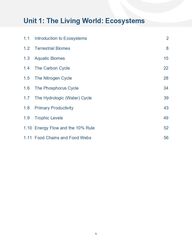
Return to flip book view
Message 1 Unit 1: The Living World: Ecosystems 1.1 Introduction to Ecosystems 2 1.2 Terrestrial Biomes 8 1.3 Aquatic Biomes 15 1.4 The Carbon Cycle 22 1.5 The Nitrogen Cycle 28 1.6 The Phosphorus Cycle 34 1.7 The Hydrologic (Water) Cycle 39 1.8 Primary Productivity 43 1.9 Trophic Levels 49 1.10 Energy Flow and the 10% Rule 52 1.11 Food Chains and Food Webs 56
Unit 1: The Living World: Ecosystems 2 Topic 1.1 Introduction to Ecosystems You Will Learn to: • Explain how species interactions are impacted by the availability of resources. By the End of the Topic, You Should Be Able to Answer: • How does the availability of resources impact living organisms? • What are the types of relationships between organisms in an ecosystem? • How do some species reduce competition for resources? Ecosystems: Biotic and Abiotic Interactions Ecosystems are composed of abiotic (nonliving) and biotic (living) components. Examples of abiotic components include minerals, precipitation, and temperatures, while biotic components include trees, animals, and bacteria. As a whole, these various components interact to make up the natural world.
Unit 1: The Living World: Ecosystems 3 Species Interactions Ecosystems consist of multiple organisms surviving together through complex interactions and relationships. One basic interaction is the predator-prey relationship, in which the predator captures, kills, and eats the prey. Predators engage in this type of relationship to obtain food resources. Because predators consume prey, an increase in the predator population generally results in a decrease in the prey population. Consequently, predators can limit the population size of prey and help maintain balance in the ecosystem. Specialized Interactions: Symbiosis
Unit 1: The Living World: Ecosystems 4 Some organisms that coexist near one another often form specialized, long-term interactions known as symbiotic relationships. These relationships are formed between species that neither compete with nor prey on one another and require the survival of both species for the relationship to exist. Symbiotic relationships include: • Mutualism—a relationship in which both species benefit. • Commensalism—a relationship in which one species benefits without harming or benefiting the other. • Parasitism—a relationship in which one species benefits at the expense of another species. Competition for Resources The types of interactions in which organisms engage are often dictated by competition (the interaction between organisms to obtain the same resources in the same ecosystem) for limited resources, such as food, water, and habitat. Competition includes: • Intraspecific competition—competition for resources between individuals from the same species. • Interspecific competition—competition for resources between individuals from different species.
Unit 1: The Living World: Ecosystems 5 To reduce the pressures of competition, some species have evolved to engage in resource partitioning (the use of resources in different ways, places, or times). For example, giraffes eat the leaves from the canopy of a tree, while gazelles eat leaves from offshoots near the ground. Things to Remember • When one organism eats another organism, the two are in a predator-prey relationship. • A long-term, physically close interaction between two species is called symbiosis. Depending on the type of interaction between the two symbiotic species, the relationship can be categorized as mutualism, commensalism, or parasitism. • Competition occurs within or between species when resources are limited. However, resource partitioning (sharing resources in different ways or places, or at different times) can reduce the negative impacts of competition.
Unit 1: The Living World: Ecosystems 6 1.1 Vocabulary Abiotic Components of the environment that are nonliving, such as minerals, precipitation, and temperature. Biotic Components of the environment that are living, such as animals, plants, and bacteria. Commensalism A symbiotic relationship between two species in which one species benefits without harming or benefiting the other. Competition The interaction between organisms who try to obtain limited resources in the same ecosystem. Ecosystems Environments where different species interact with various abiotic and biotic factors. Intraspecific competition Competition for resources between individuals of the same species. Interspecific competition Competition for resources between individuals from different species. Mutualism A symbiotic relationship between two species in which both species benefit from the relationship. Parasitism A symbiotic relationship in which one species benefits at the expense of another species. Predator-prey relationship A relationship in which one organism, known as the predator, captures, kills, and eats another organism, known as the prey. Resource partitioning When two species make use of the same resource in different ways, places, or time. Symbiotic relationships A specialized long-term relationship between two species in which species neither compete nor prey on one another.
Unit 1: The Living World: Ecosystems 7 1.1 Check for Understanding 1. How do predators keep populations of certain species in balance? A. By altering abiotic factors B. By consuming prey C. By forming symbiotic relationships D. By creating biomes 2. Which symbiotic relationship benefits one species without harming or benefiting the other? A. Mutualism B. Predatism C. Parasitism D. Commensalism 3. Which of the following is an example of resource partitioning? A. Multiple bird species nesting in different parts of a tree B. Rodent species competing for resources C. Bacteria providing nutrients for plants D. Top predators consuming primary consumers